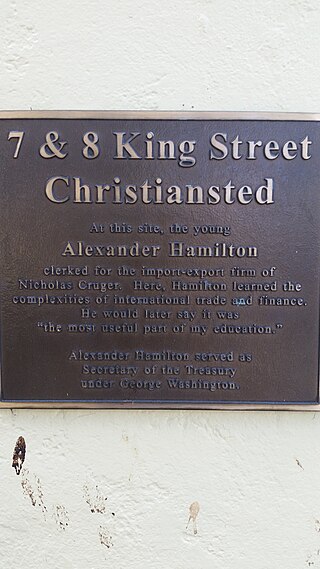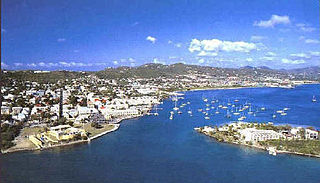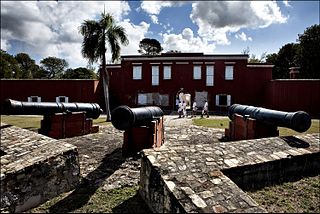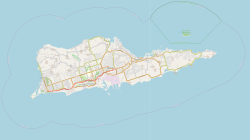
The United States Virgin Islands, officially the Virgin Islands of the United States, are a group of Caribbean islands and an unincorporated and organized territory of the United States. The islands are geographically part of the Virgin Islands archipelago and are located in the Leeward Islands of the Lesser Antilles to the east of Puerto Rico and west of the British Virgin Islands.

Saint Croix is an island in the Caribbean Sea, and a county and constituent district of the United States Virgin Islands (USVI), an unincorporated territory of the United States.

The African Methodist Episcopal Zion Church, or the AME Zion Church (AMEZ) is a historically African-American Christian denomination based in the United States. It was officially formed in 1821 in New York City, but operated for a number of years before then. The African Methodist Episcopal Zion Church adheres to Wesleyan-Arminian theology.

Christiansted is the largest town on Saint Croix, one of the main islands composing the United States Virgin Islands, a territory of the United States of America. The town is named after King Christian VI of Denmark.

Frederiksted is both the town and one of the two administrative districts of St. Croix, U.S. Virgin Islands. It is a grid-planned city, designed by surveyor Jens Beckfor, originally to 14x14 blocks but built 7x7 to enhance the island commerce in the 1700s. Frederiksted has fewer than 1,000 people in the town proper, but nearly 10,000 in the greater western side of the island. Christiansted is about 30 years older but commerce was limited by its natural, shallow protective reef. Frederiksted was built in the leeward side of the island for calm seas and a naturally deep port. It is home to Fort Frederik, constructed to protect the town from pirate raids and attacks from rival imperialist nations and named after Frederick V of Denmark, who purchased the Danish West Indies in 1754.
Virgin Islands Creole, or Virgin Islands Creole English, is an English-based creole consisting of several varieties spoken in the Virgin Islands and the nearby SSS islands of Saba, Saint Martin and Sint Eustatius, where it is known as Saban English, Saint Martin English, and Statian English, respectively.

St. Paul's Chapel is a chapel building of Trinity Church, an episcopal parish, located at 209 Broadway, between Fulton Street and Vesey Street, in Lower Manhattan, New York City. Built in 1766, it is the oldest surviving church building in Manhattan, and one of the nation's finest examples of Late Georgian church architecture.
Juan Francisco Luis was a U.S. Virgin Islander politician who served as the third elected Governor of the United States Virgin Islands. He is the territory's 23rd governor overall. Luis assumed the governorship on January 2, 1978, succeeding Governor Cyril King, who died in office. He held the governor's office from 1978 until 1987, becoming the longest-serving governor in the history of the U.S. Virgin Islands.

The Episcopal Diocese of the Virgin Islands is a diocese of the Episcopal Church in the United States of America (ECUSA) which includes both the United States Virgin Islands and the British Virgin Islands. The diocese is a part of Province II of the Episcopal Church. The current Diocesan Bishop of the Virgin Islands is the Edward Ambrose Gumbs. The cathedral church of the diocese is the Cathedral Church of All Saints, Charlotte Amalie. The diocese currently comprises 14 churches. There is a functioning parish school on St. Thomas All Saints Cathedral School there was an academic campus on St. Croix, St. Dunstan's Episcopal High School. St. Dunstan's closed in the 1990s. There is also the St. Georges School located on the parish property of St. Georges Episcopal Church in Road Town, Tortola in the British Virgin Islands, which also opened the St. Georges School in Palestina Estate near to the St. Paul's Episcopal Church in Sea Cow's Bay, Tortola in the British Virgin Islands. There is also the St. Mary's School located on the parish property of the St. Mary's Episcopal Church in Valley, Virgin Gorda in the British Virgin Islands.
Stateside Virgin Islands Americans are West Indian Americans who hold US citizenship and who have migrated from the U.S. Virgin Islands to the continental United States and Hawaii, and their descendants.

Calvary Episcopal Church is a parish of the Episcopal Diocese of Pittsburgh, Pennsylvania. The parish was founded in 1855.

St. John's is an Episcopal church located in Hampton, Virginia, United States, within the Episcopal Diocese of Southern Virginia. Established in 1610, St. John's is the oldest English-speaking parish in continuous existence in the United States of America.

St. John's Episcopal Church is a parish church in the Episcopal Diocese of Iowa. It is located in Keokuk, Iowa, United States. It was listed, together with the parish hall, on the National Register of Historic Places in 1989.
Ansetta de Chabert (1908–1976), was a businesswoman and civic activist from Saint Croix, U.S. Virgin Islands. She was married first to Ralph de Magne de Chabert Sr., a local civil servant, farmer, and real estate investor. After his death, she married Reverend Clarke, the vicar of St. John's Episcopal Church in Christiansted. After her death she was honoured by Resolution 778, March 1, 1976, of the Virgin Islands legislature, which commemorated her "lifetime of human warmth, noble pursuits and good works throughout the Virgin Islands community". In 2005 she was one of 13 women inducted into the Virgin Islands Women's Hall of Fame.
Derek M. Hodge was an American Virgin Islander politician and lawyer who served as the Lieutenant Governor of the United States Virgin Islands for two terms from 1987 to 1995 under Governor Alexander Farrelly. The Virgin Islands Daily News called him a "towering figure in local politics," referring to his political career, which spanned several decades.
St. Luke's Episcopal Church is located at 615 Vermillion Street in historic downtown Hastings, Minnesota, United States.

Mount Calvary Church is a Catholic parish located in the Seton Hill neighborhood of Baltimore, Maryland. The church was founded in 1842 as a mission congregation within the Episcopal Church and is now a community within the Personal Ordinariate of the Chair of Saint Peter of the Catholic Church.

Arnold Ray Highfield was an American professor, historian, writer, and poet, best known for his historical works on the Danish West Indies and the United States Virgin Islands.

Ruby M. Rouss was an American citizen born on Saint Croix in the US Virgin Islands. Her career was marked by a series of firsts. She was the first Virgin Islander in the Women's Army Corps (WAC), first African-American woman to serve on General Eisenhower’s staff, and first black woman assigned as a permanent staff of Supreme Headquarters Allied Powers Europe. After a 20-year military career, she retired from service and became the first woman parole officer in St. Croix. In 1973, she was elected as one of the first women to serve in the Virgin Island's legislature. In 1981, Rouss served as the first female President of the Virgin Islands Legislature, becoming the first black woman to lead a legislature in the United States. She was elected to serve a second presidency of the Senate in 1987 and died the following year. Posthumously, she was inducted into the Virgin Island's Women's Hall of Fame and a housing project in St. Croix was renamed in her honor.

U.S. Virgin Islands Governor's Mansion may refer to any one of the three official residences owned by the government of the U.S. Virgin Islands and provided to the Governor of the United States Virgin Islands. One residence is located on each of the three largest inhabited islands of this U.S. territory in the Caribbean. The U.S. Virgin Islands maintains more official gubernatorial residences than any other state or territory of the United States.



















